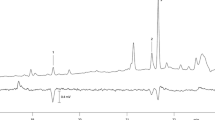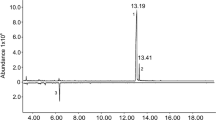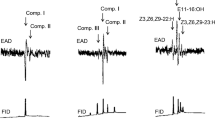Abstract
Archips atrolucens, Adoxophyes privatana, and Homona sp. are serious defoliators of citrus trees in the Mekong Delta of Vietnam. In order to establish a sustainable pest-management program for the three species, their female-produced sex pheromones were investigated by GC-EAD and GC-MS analyses, and the following multi-component pheromones were identified: (Z)-11-tetradecenyl acetate (Z11-14:OAc), (E)-11-tetradecenyl acetate (E11-14:OAc), and tetradecyl acetate (14:OAc) in a ratio of 64:32:4 for A. atrolucens; Z11-14:OAc and (Z)-9-tetradecenyl acetate (Z9-14:OAc) in a ratio of 92:8 for A. privatana; and Z11-14:OAc and (Z)-9-dodecenyl acetate (Z9-12:OAc) in a ratio of 96:4 for Homona sp. Each lure baited with synthetic components as a mimic of the natural pheromone attracted males of the target species specifically, indicating that each monounsaturated minor component plays a significant role for mating communication and reproductive isolation of the three species inhabiting the same citrus orchards. In an extract of the pheromone glands of A. atrolucens females, the content of 14:OAc was very low, but a synergistic effect was observed clearly when the saturated compound was mixed at the same level as the E11-14:OAc. The synthetic lures will provide useful tools for monitoring flights of adults of the three species.


Similar content being viewed by others
References
Ando T (2012) Internet database: http://www.tuat.ac.jp/~antetsu/LepiPheroList.htm
Ando T, Yamakawa R (2011) Analyses of lepidopteran sex pheromones by mass spectrometry. Trends Anal Chem 30:990–1002
Ando T, Kuroko H, Nakagaki S, Saito O, Oku T, Takahashi N (1978) Two-component sex attractants for male moths of the subfamily Tortricinae (Lepidoptera). Agric Biol Chem 42:1081–1083
Buser H-R, Arn H, Guerin P, Rauscher S (1983) Determination of double bond position in mono-unsaturated acetates by mass spectrometry of dimethyl disulfide adducts. Anal Chem 55:818–822
Cardé RT, Cardé AM, Hill AS, Roelofs WL (1977) Sex pheromone specificity as a reproductive isolating mechanism among the sibling species Archips argyrosphilus and A. mortuanus and other sympatric Tortricine moths (Lepidoptera: Tortricidae). J Chem Ecol 3:71–84
El-Sayed AM (2012) Internet database: http://www.pherobase.com/
Hai TV, Vang LV, Son PK, Inomata S, Ando T (2002) Sex attractants for moths of Vietnam: field attraction by synthetic lures baited with known lepidopteran pheromones. J Chem Ecol 28:1473–1481
Hai TV, Xuan TT, Son PK (2009) Investigation of biological characteristics of the peanut leafroller, Archips micacerana Walker, and evaluation of the efficacy of some Metarhizium anisopliae isolates on this species in Tra Vinh province. Sci J Can Tho Univ 11:54–62, in Vietnamese
Huynh NV, Sen LT (2011) Insect pests of crop. Agriculture Press, pp. 106–107 (in Vietnamese)
Kochansky JP, Roelofs WL, Sivapalan P (1978) Sex pheromone of the tea tortrix moth (Homona coffearia Neitner). J Chem Ecol 4:623–631
Nicetic O, Huan NH, Chien HV, Cuc NTT, Hai TV, Oanh PH, Toan NB, Minh D (2007) Identification of pests and natural enemies in citrus orchards. Agriculture Press, pp. 68–69 (in Vietnamese)
Noguchi H, Tamaki Y, Yushima T (1979) Sex pheromone of the tea tortrix moth: isolation and identification. Appl Entomol Zool 14:225–228
Razoski J (2009a) Tortricidae from Vietnam in the collection of the Berlin Museum. 5. Archipini and Sparganothini (Lepidoptera: Tortricidae). SHILAP Revta Lipid 37:41–60
Razoski J (2009b) Tortricidae from Vietnam in the collection of the Berlin Museum. 7. Some additional data (Lepidoptera: Tortricidae). Pol J Entomol 78:15–32
Spitzer K, Rejmánek M, Soldán T, Zelený J (1983) Flight activity of some moths (Lepidoptera) monitored by sex pheromones in Vietnam: dry season. Acta Entomol Bohemoslov 80:413–418
Vang LV, Inomata S, Kinjo M, Komai F, Ando T (2005) Sex pheromones of five Olethreutine species (Lepidoptera: Tortricidae) associated with the seedlings and fruits of mangrove plants in the Ryukyu Islands, Japan: identification and field evaluation. J Chem Ecol 31:859–878
Whittle CP, Bellas TE, Horak M, Pinese B (1987) The sex pheromone and taxonomic status of Homona spargotis meyrick sp. rev., an Australian pest species of the Coffearia group (Lepidoptera: Tortricidae: Tortricinae). J Aust Entomol Soc 26:169–179
Yang CY, Han KS, Boo KS (2009) Sex pheromones and reproductive isolation of three species in genus Adoxophyes. J Chem Ecol 35:342–348
Acknowledgment
The authors are grateful to Drs. Fumiaki Mochizuki and Takehiko Fukumoto of Shin-Etsu Chemical Co., Ltd., for supplying synthetic tetradecenyl acetates. This study was supported in part by grant-in-aid to JSPS Fellows (22·00097).
Author information
Authors and Affiliations
Corresponding author
Rights and permissions
About this article
Cite this article
Van Vang, L., Thuy, H.N., Khanh, C.N.Q. et al. Sex Pheromones of Three Citrus Leafrollers, Archips atrolucens, Adoxophyes privatana, and Homona sp., Inhabiting the Mekong Delta of Vietnam. J Chem Ecol 39, 783–789 (2013). https://doi.org/10.1007/s10886-013-0291-2
Received:
Revised:
Accepted:
Published:
Issue Date:
DOI: https://doi.org/10.1007/s10886-013-0291-2




